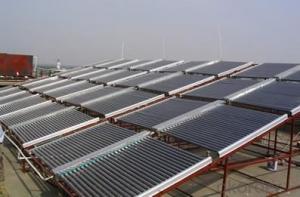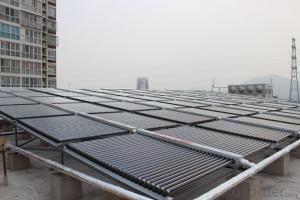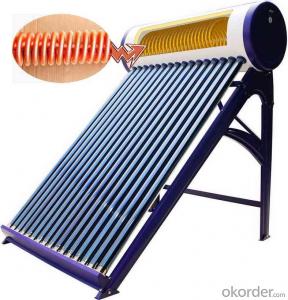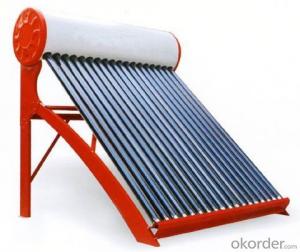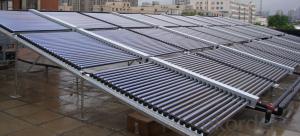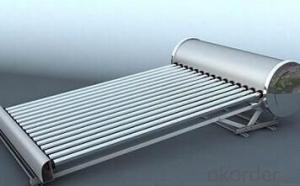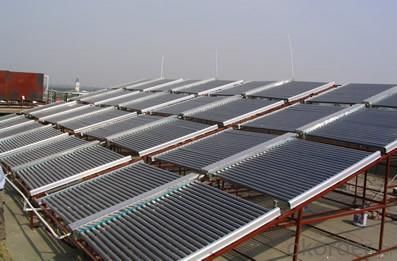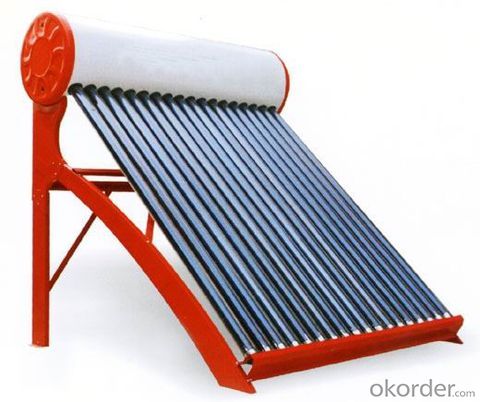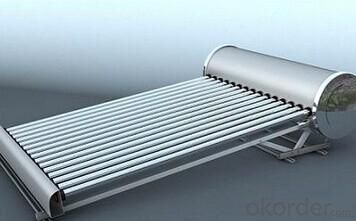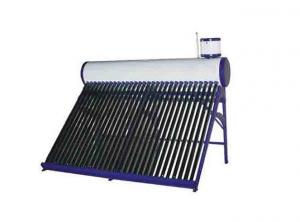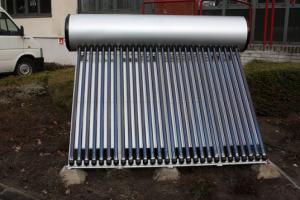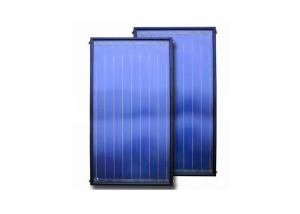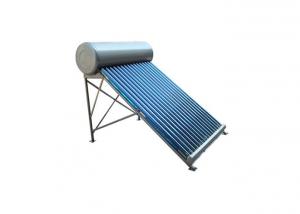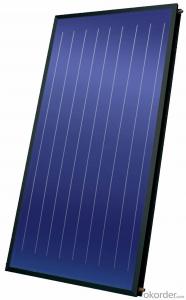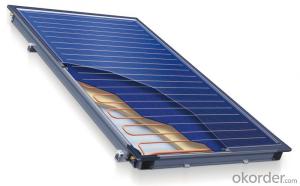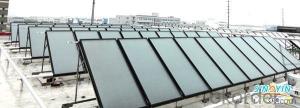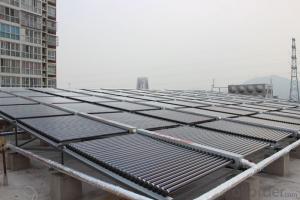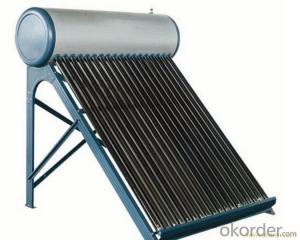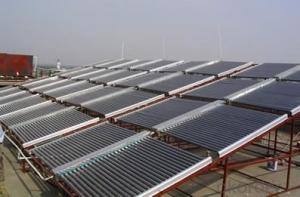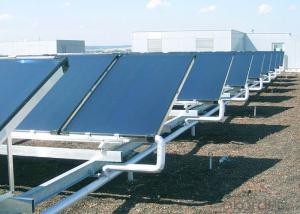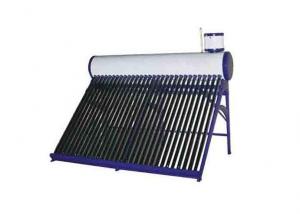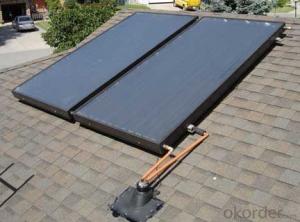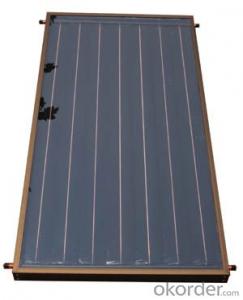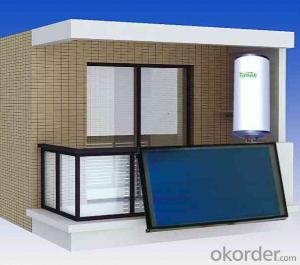Pavement Solar Collectors Pressurized Heat Pipe Solar Water Heater System New Designed
- Loading Port:
- China main port
- Payment Terms:
- TT OR LC
- Min Order Qty:
- 1 set
- Supply Capability:
- 6000 set/month
OKorder Service Pledge
OKorder Financial Service
You Might Also Like
Introduction of Non-Pressure Solar Water Heater:
Non-pressure Solar Heater is one of the most economical solar water heating device with pretty high efficiency at the same time. It consists of hot water storage tank, solar vacuum tubes with mouth plug in storage tank, and bracket supporting tank and tubes.When cold water in evacuated tubes is heated with solar irradiation, as the specific gravities of hot water and cold water are different, hotter water goes upward to storage tank and colder water goes downward to glass tubes. through this continuous circulation, the cold water in storage tank will be gradually heated till sunset.
Specialty:
1. High thermal performance and working temperature: the heat exchanging rate even in winter can up above 55%.
2. Heat collecting efficiency is at least 20% above common solar systems.
3. Work in all day and all season: no matter any corner of the world, this system can work well even -40℃ to avoid the tube freezing problem.
4. Reliability: No water following through the tube, so water scale can not generate and tube cracks could be avoided, the system still can keep working even with some damaged tubes.
5. It can connect with water tap and work automatically with pressure0.6Mpa, bring enjoyable washing experience.
6. Safety: P/T valve would release pressure and temperature to protect tank..
Technical Specification:
1. Outer tank material: SUS304 stainless steel or powder coated color steel
2. Inner tank material: 1.2mm thick SUS304 food grade stainless steel ( Optional material SUS316L)
3. Vacuum tube material: borosilicate glass 3.3; AL-SS-CU absorb coating, with copper heat pipe inside
4. Frame material: 1.2mm thickness stainless steel
5. Insulation material: 55mm thickness polyurethane
6. Suitable for mains pressure water(up to 8 bar/116psi)
7. Easy plug-in installation
8. Install the T/P valve on the pressurized tank
9. Seal material: Stabilized High Temperature Silicon
Outer tank material: SUS304 stainless steel or powder coated color steel
Inner tank material: 1.2mm thick SUS304 food grade stainless steel ( Optional material SUS316L)
Vacuum tube material: borosilicate glass 3.3; AL-SS-CU absorb coating, with copper heat pipe inside
Frame material: 1.2mm thickness stainless steel
Insulation material: 55mm thickness polyurethane
Suitable for mains pressure water(up to 8 bar/116psi)
Easy plug-in installation
Install the T/P valve on the pressurized tank
Seal material: Stabilized High Temperature Silicon
19. Vacuum Tube | 20. Size (mm) | 21. Φ47*1500 / Φ58*1800 / Φ70*2100 | |||||
22. Tube (pcs) | 23. 10 / 12 / 15 / 18 / 20 / 22 / 24 / 30 / 36 / 42 | ||||||
24. Material | 25. Borosilicate 3.3 glass, magnetron spluttering selective coating | ||||||
26. Coating | 27. Single-target AL-N/AL or Three-target AL/N-Cu-SS | ||||||
28. Water Tank | 29. Capacity | 30. 80L ~ 500L for hot water storage tank | |||||
31. Inner tank | 32. Food-grade stainless steel SUS304-2B / SUS316 | ||||||
33. Insulation | 34. High-density polyurethane foam with 70~80 hour heat preservation | ||||||
35. Tank shell | 36. Food-grade stainless steel SUS304-2B | ||||||
37. Bracket | 38. Shaped strong aluminum alloy structure adaptable for flat or slope roof | ||||||
39. Accessories | 40. Anti-aging silicon seals, Dustproof seals, Air-vent cap, Stainless screws | ||||||
41. Auxiliary Devices | 42. Assistant tank, Intelligent controller, Electrical heater, Magnesium anodes | ||||||
43. Tilt Angle | 44. 25 ~ 50° | ||||||
45. Water Output | 46. 45 - 95°C | ||||||
47. Hail Resistance | 48. Φ25mm diameter | ||||||
49. Model Number | 50. Solar Vacuum Tube | 51. Tank 52. Liter | 53. System 54. Liter | 55. Container Loading Qty /sets | |||
56. Size /mm | 57. Qty /pcs | 58. 20GP | 59. 40GP | 60. 40HQ | |||
61. VNS-58SA12-100 | 62. Φ58*1800 | 63. 12 | 64. 100 | 65. 132 | 66. 58 | 67. 119 | 68. 140 |
69. VNS-58SA15-130 | 70. 15 | 71. 130 | 72. 170 | 73. 54 | 74. 108 | 75. 131 | |
76. VNS-58SA18-150 | 77. 18 | 78. 150 | 79. 198 | 80. 43 | 81. 86 | 82. 105 | |
83. VNS-58SA20-170 | 84. 20 | 85. 170 | 86. 223 | 87. 40 | 88. 80 | 89. 97 | |
VNS-58SA24-200 | 24 | 200 | 263 | 35 | 70 | 85 | |
VNS-58SA30-250 | 30 | 250 | 329 | 28 | 56 | 68 | |
VNS-58SA36-300 | 36 | 300 | 395 | 23 | 47 | 57 | |
Product Show
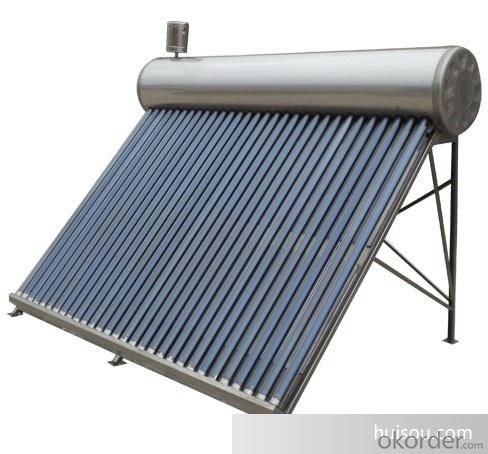
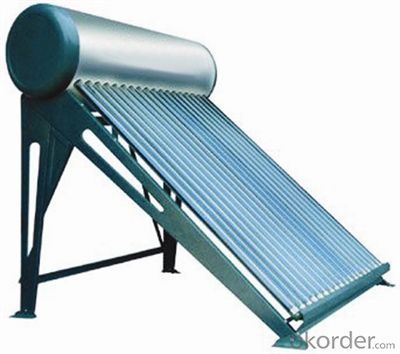
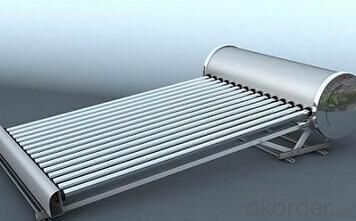
Our Services
1. OEM service
2. Warranty: 5 years
3. Considerable after sale service
Color steel Compact pressure Thermal solar heater
FAQ:
1. What’s the delivery time?
10 days after receiving deposit.
2. How long is the warranty?
5 years for whole system, 1 year for accessory
3. What’s your production capacity?
6000sets/month
4. What’s the MOQ?
1 set.
5. What’s your payment term?
Container: 30% T/T in advance for deposit, 70% T/T before shipment for fist order.
70% T/T after seeing copy of B/L from second order
Sample: 100% T/T in advance
Other choices: L/C at sight.
6. What certifications do you have?
CE, SOLAR KEYMARK, SRCC and etc.
- Q: Can solar collectors be used for heating car manufacturing plants?
- Yes, solar collectors can be used for heating car manufacturing plants. Solar thermal systems can provide heat for various industrial processes, including space heating, water heating, and even specific manufacturing processes. By harnessing solar energy, car manufacturing plants can reduce their reliance on fossil fuels and lower their carbon footprint.
- Q: Can solar collectors be used for heating monasteries?
- Yes, solar collectors can indeed be used for heating monasteries. Solar collectors, such as solar thermal panels, can harness the sun's energy to heat water or air, which can then be used for space heating in monasteries. This renewable energy source can help reduce the reliance on fossil fuels and lower carbon emissions, making it a sustainable and cost-effective heating solution for monasteries.
- Q: What is the maintenance cost for solar collectors?
- The maintenance cost for solar collectors can vary depending on the type and size of the system, as well as the specific components used. Generally, the maintenance cost for solar collectors is relatively low compared to other forms of energy generation. One of the main maintenance tasks for solar collectors is cleaning the panels to ensure optimal efficiency. This can be done using water and a soft cloth or sponge. In some cases, if the panels are installed at an angle, rainwater may be sufficient to keep them clean. Regular inspection of the system is also important to identify any issues or damage that may require repairs. This includes checking for loose connections, damaged wiring, or any signs of wear and tear. It is recommended to have a professional technician perform these inspections to ensure safety and proper functioning of the system. In terms of costs, routine maintenance for solar collectors typically involves minimal expenses. Cleaning supplies, such as water and cleaning agents, may be required, but these are generally low-cost items. If any repairs or replacements are needed, such as fixing a broken panel or replacing a faulty component, the cost will depend on the specific issue and the extent of the repair. Overall, while there are some maintenance tasks and potential costs associated with solar collectors, they are generally minimal compared to the long-term benefits and savings provided by solar energy.
- Q: Can solar collectors be used for heating shopping malls and retail centers?
- Yes, solar collectors can be used for heating shopping malls and retail centers. Solar thermal systems can capture and convert sunlight into heat energy, which can then be used for space heating and water heating in commercial buildings. By utilizing solar collectors, shopping malls and retail centers can reduce their reliance on fossil fuels and lower their carbon footprint while achieving cost savings in heating operations.
- Q: Is it possible to store excess energy generated by solar collectors?
- Yes, it is possible to store excess energy generated by solar collectors. This can be achieved through the use of batteries or other storage systems, allowing the surplus energy to be utilized during periods of low or no solar generation.
- Q: Are solar collectors suitable for military applications?
- Yes, solar collectors are suitable for military applications. They provide a reliable and sustainable source of energy that can power various military equipment, including communication systems, surveillance devices, and remote outposts. Solar collectors are portable, easy to deploy, and require minimal maintenance, making them ideal for military operations in remote and challenging environments. Additionally, their use reduces the reliance on traditional fuel sources, enhances operational flexibility, and promotes energy independence for military forces.
- Q: Can solar collectors be used for heating stadiums?
- Yes, solar collectors can be used for heating stadiums. By harnessing the sun's energy, solar collectors can generate heat that can be used to warm up large spaces like stadiums. This can be achieved through various solar heating systems, such as solar thermal collectors or solar air heating systems.
- Q: Can solar collectors be used for heating restaurants?
- Yes, solar collectors can be used for heating restaurants. Solar thermal systems can be installed to harness the sun's energy and convert it into heat, which can then be used for various heating purposes in restaurants, including space heating and water heating. This can provide a sustainable and cost-effective alternative to traditional heating systems, reducing reliance on fossil fuels and lowering energy costs.
- Q: Are solar collectors suitable for heating museums and art galleries?
- Yes, solar collectors are suitable for heating museums and art galleries. They provide a sustainable and cost-effective method of heating, while also ensuring a consistent and comfortable indoor climate for preserving delicate artworks and artifacts. Additionally, solar collectors can be integrated into the architectural design of the building without compromising its aesthetics.
- Q: Can solar collectors be used in military installations?
- Yes, solar collectors can be used in military installations. They offer a reliable and sustainable source of energy, reducing dependence on traditional fossil fuels and enhancing operational efficiency. Solar collectors can power various systems, including lighting, heating, and cooling, as well as provide electricity for communication equipment and charging stations. Additionally, their versatility allows for easy integration into different military infrastructure, making them a viable option for military installations.
Send your message to us
Pavement Solar Collectors Pressurized Heat Pipe Solar Water Heater System New Designed
- Loading Port:
- China main port
- Payment Terms:
- TT OR LC
- Min Order Qty:
- 1 set
- Supply Capability:
- 6000 set/month
OKorder Service Pledge
OKorder Financial Service
Similar products
Hot products
Hot Searches
Related keywords
